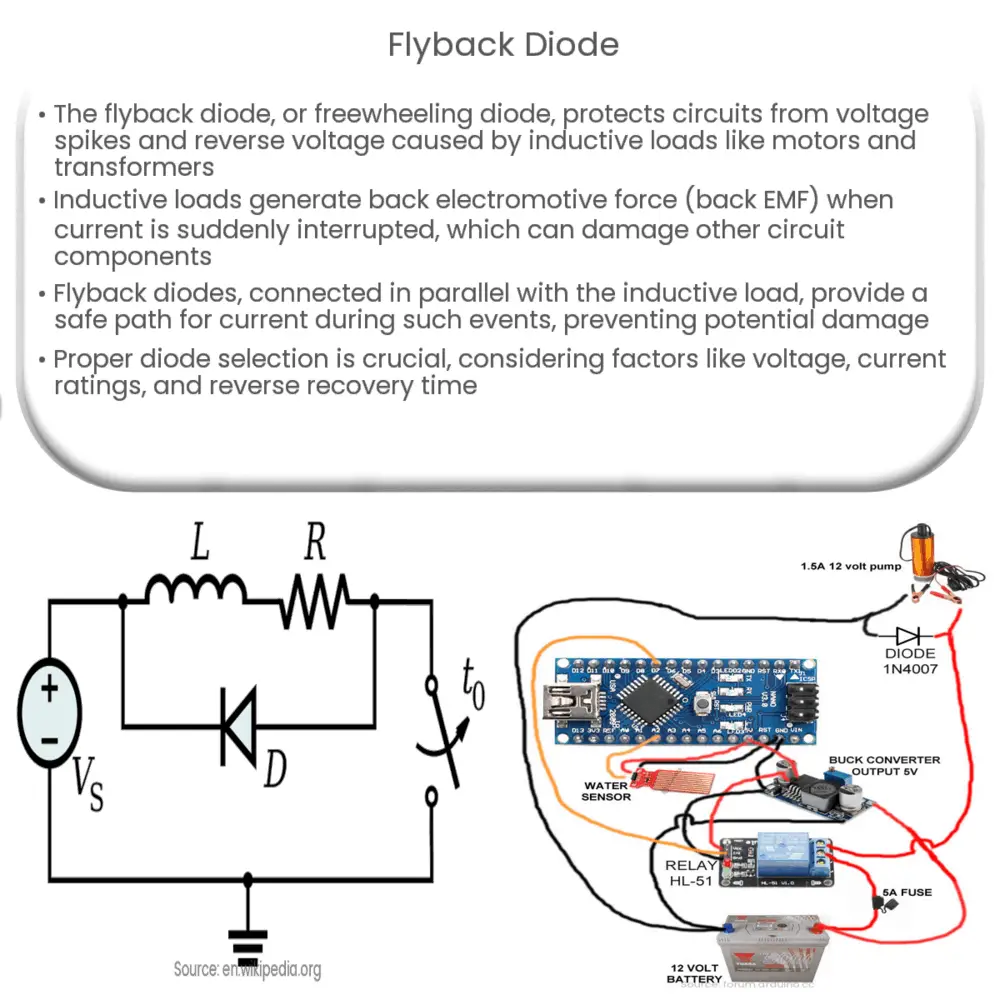A flyback diode protects electrical circuits from voltage spikes and reverse voltage caused by inductive loads like motors and transformers.

Flyback Diode: An Essential Component for Protecting Your Circuit
Introduction
A flyback diode, also known as a freewheeling diode, is a critical component used to protect electrical circuits from voltage spikes and reverse voltage. This component is particularly important when working with inductive loads, such as motors, solenoids, and transformers. In this article, we will explore the principles behind the flyback diode, its function, and its various applications.
Understanding Inductive Loads and Back EMF
To appreciate the importance of a flyback diode, it is necessary to understand the behavior of inductive loads. An inductive load is a type of electrical device that stores energy in a magnetic field when current flows through it. Examples include motors, solenoids, and transformers. When the current in an inductive load is suddenly interrupted, the magnetic field collapses, and a voltage spike, known as back electromotive force (back EMF), is generated. This back EMF can cause damage to other components in the circuit and lead to system failure if not properly managed.
Function of the Flyback Diode
A flyback diode serves to protect the circuit from the harmful effects of back EMF. When connected in parallel with the inductive load, the diode provides a path for the current to flow when the load is suddenly disconnected. The flyback diode is placed in reverse bias, meaning it will not conduct current under normal operating conditions. However, when the back EMF is generated, the diode becomes forward-biased, allowing the current to flow through it and dissipate the stored energy in the inductive load.
By providing a safe path for the current, the flyback diode helps prevent voltage spikes that could damage other components in the circuit. This protection is particularly important when working with sensitive components like microcontrollers, which can be easily damaged by voltage spikes.
Selection and Sizing of Flyback Diodes
Choosing the right flyback diode for a given application is crucial to ensure adequate protection. Several factors must be considered when selecting a flyback diode, including the voltage and current ratings, the reverse recovery time, and the diode’s physical size.
The voltage rating of the flyback diode should be higher than the maximum voltage generated by the inductive load. Similarly, the current rating should be greater than the maximum current expected to flow through the diode. The reverse recovery time, which is the time it takes for the diode to switch from conducting to non-conducting, should be as short as possible to minimize energy dissipation and heat generation. Finally, the physical size of the diode should be considered to ensure it can be easily incorporated into the circuit design.
Types of Flyback Diodes
There are several types of diodes suitable for use as flyback diodes, each with its own characteristics and benefits. Some common types include:
- Standard Diodes: These are the most basic type of diodes and can be used as flyback diodes for low-frequency applications with moderate voltage and current ratings.
- Fast Recovery Diodes: As the name suggests, these diodes have a shorter reverse recovery time, making them suitable for high-frequency applications where rapid switching is required.
- Schottky Diodes: Schottky diodes have very low forward voltage drops and even faster reverse recovery times than fast recovery diodes. They are ideal for high-frequency and high-efficiency applications but have lower voltage and current ratings compared to other diode types.
Applications of Flyback Diodes
Flyback diodes are widely used across various industries and applications due to their ability to protect circuits from voltage spikes and reverse voltage. Some common applications include:
- DC Motors: Flyback diodes protect the motor driver circuitry from back EMF generated when the motor is suddenly stopped or reversed.
- Relays and Solenoids: Relays and solenoids generate back EMF when the coil is de-energized, and a flyback diode helps protect the control circuitry from damage.
- Switching Power Supplies: Flyback diodes are used in the design of switching power supplies to protect against voltage spikes that may occur during the switching process.
- Inductive Load Protection: Flyback diodes are employed in various other applications involving inductive loads, such as transformers and inductors, to prevent voltage spikes and protect the surrounding components.
Conclusion
In conclusion, the flyback diode is an essential component for safeguarding electrical circuits from the harmful effects of back EMF generated by inductive loads. By understanding the principles behind the flyback diode, its function, and its various applications, designers can ensure the longevity and reliability of their electronic systems. Proper selection and sizing of flyback diodes, based on the voltage and current ratings, reverse recovery time, and physical size, will help to guarantee the optimal protection of sensitive components and maintain the overall performance of the circuit.

